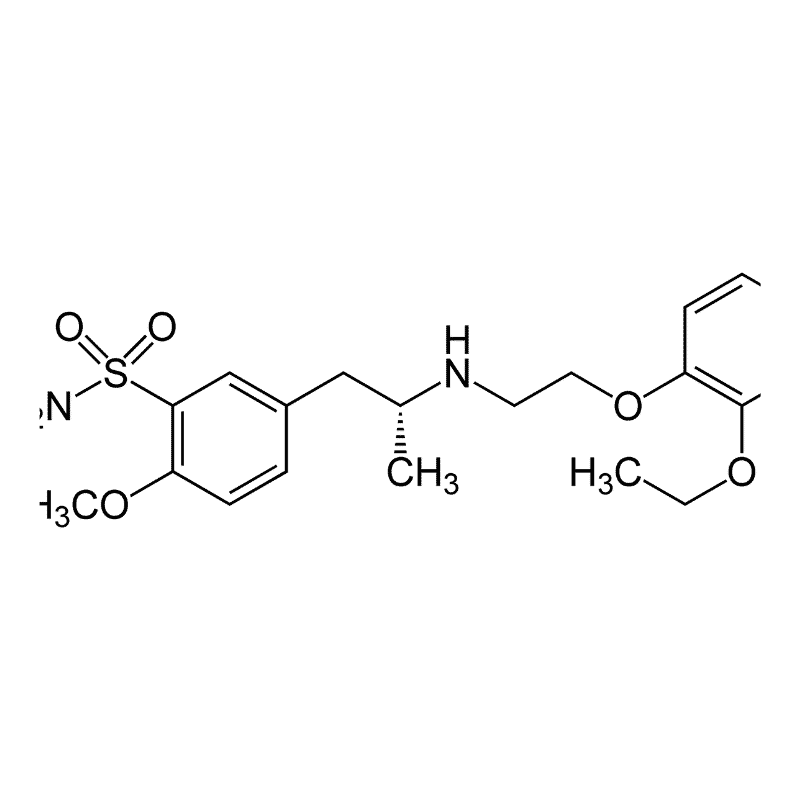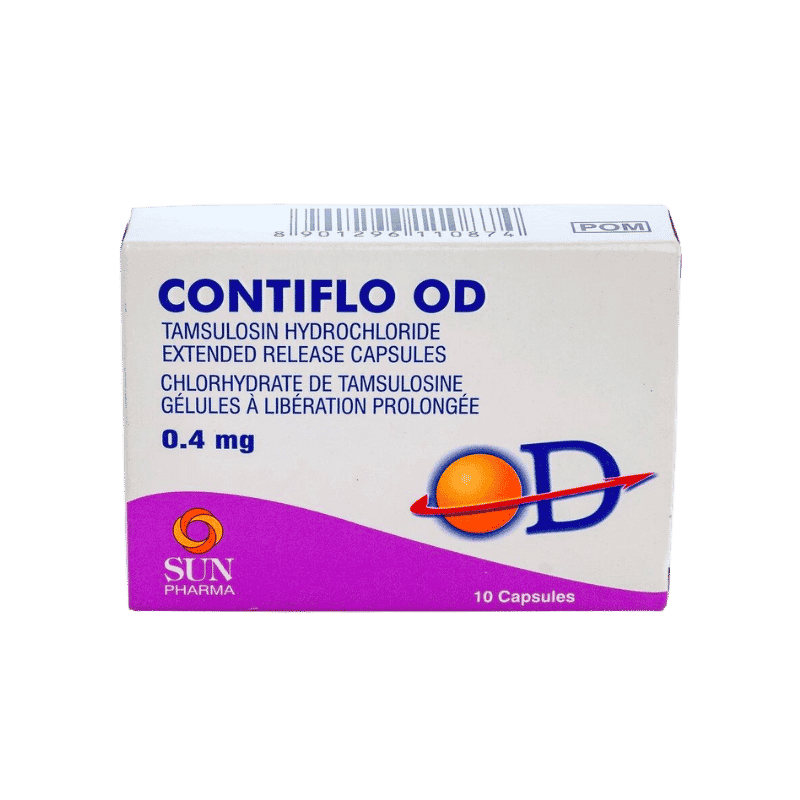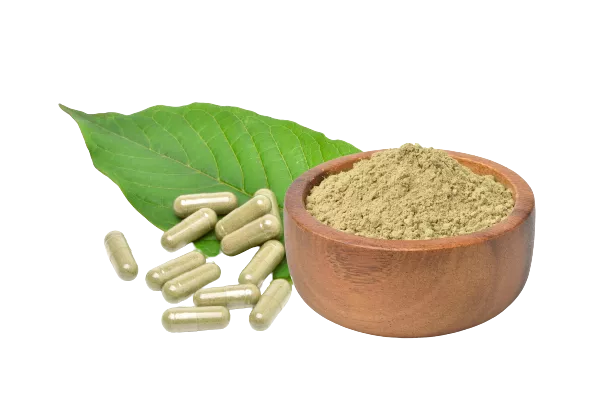Does Kratom Interact With Tamsulosin?
When two drugs that have opposite effects on the body are taken together, their effects could be hindered or canceled out. This phenomenon is commonly known as an antagonistic interaction.
Kratom and tamsulosin are antagonists —meaning kratom can hinder tamsulosin’s effects and reduce its effectiveness. The risks of this interaction can be moderate to high.
Do not consume these drugs together without consulting your physician.
The interaction of kratom with tamsulosin can occur in the following ways:
Decreased Effects (Antagonistic Interaction)
Kratom and tamsulosin are considered antagonist drugs. Kratom is an alpha-2 adrenergic receptor agonist [1]. When the active metabolites of kratom bind to these receptors, they cause vasoconstriction, papillary constriction, and constriction of smooth muscles in the genitourinary tract.
Tamsulosin is an alpha-1 receptor antagonist [2]. Blocking the α1 adrenoreceptors produces relaxation and dilation of the smooth muscle in the genitourinary tract.
Thus, because kratom and tamsulosin have opposite effects mediated by the alpha-adrenergic receptors, they will become ineffective if combined.
Slowed Elimination (Metabolic Competition)
The cytochrome P450 enzymes (CYP) in the liver are responsible for metabolizing most of the drugs and supplements we consume.
When two drugs that require the same CYP enzymes are taken simultaneously, they compete to bind to such enzymes. This is called metabolic competition — and it results in a slower metabolism rate and an increased concentration of the drugs in the bloodstream.
Tamsulosin is mainly metabolized in the liver by the CYP3A4 and CYP2D6 enzymes [3]. And, it turns out, CYP3A4 and CYP2D6 are also responsible for the metabolization of kratom [4].
Consuming kratom and tamsulosin slows down their metabolism rate, causing them to accumulate in the body and remain in the bloodstream for longer. It also significantly increases the chances of experiencing side effects of both compounds.
Kratom & Alpha-Blockers Interactions
Tamsulosin is an alpha-adrenergic receptor blocker. The drug mainly acts on alpha-1 adrenergic receptors. The medication dilates blood vessels, resulting in hypotension. It is helpful in benign prostatic hyperplasia, prostatitis, voiding dysfunction, and ureteric stones.
Other alpha-blockers with kratom will have similar reactions and include the following:
- Alfuzosin
- Doxazosin (Cardura)
- Phenoxybenzamine
- Phentolamine
- Prazosin (Minipress)
- Terazosin
- Tolazoline
- Trazodone
- Silodosin

Is it Safe to Take Kratom With Tamsulosin?
No. It is not safe to take kratom with tamsulosin.
The interaction between kratom and tamsulosin is considered moderate to high.
Kratom and tamsulosin act via alpha-adrenergic receptors. Kratom increases blood pressure in higher doses, while tamsulosin decreases blood pressure. Similarly, kratom reduces tamsulosin’s effect of relaxing smooth muscles in the genitourinary tract.
Consult a physician before consuming kratom and tamsulosin together. A severe drop in blood pressure requires quick medical intervention.

What is Tamsulosin?
Tamsulosin is an alpha-1 receptor blocker. The drug affects smooth muscles, especially the bladder’s neck, and prostate detrusor muscles, enabling free urine flow [5]. In addition, it also acts on smooth-muscled blood vessels, resulting in decreased blood pressure.
This medication is primarily used to treat benign prostatic hyperplasia and prostatitis in men. It is also used for the symptomatic treatment of ureteral stones and female voiding dysfunction.
Tamsulosin Details

| Drug Name | Tamsulosin |
| Trade names | Betamsal, Contiflo XL, Flomax, Flomaxtra, Harnal D, Maxrin, Mecir, Omexel, Omipro, Omix, Omnic, Pradif, Ranomax, Salover, Secotex, Stronazon, Tamsact, Tamsol, Tamsul, Urimax |
| Classification | Alpha Adrenergic Receptor Blockers |
| CYP Metabolism | CYP3A4, CYP2D6 |
| Interaction With Kratom | Antagonistic |
| Risk of Interaction | Moderate |
What is Tamsulosin Used for?
Tamsulosin is used in the treatment of various urinary pathologies. The indications for the use of tamsulosin are:
Benign Enlargement of Prostate
Tamsulosin aids effortless urination in men who have benign prostatic hyperplasia (BPH). The drug acts by blocking alpha-1 adrenergic receptors in the genitourinary tract’s and relaxing the muscles, especially the bladder’s detrusor muscles and prostatic muscles, allowing easy passage of urine through the urethra.
Benign prostatic hyperplasia patients present with lower urinary tract symptoms. These symptoms are classified into two sub-categories. The irritative or storage symptoms include frequency, urgency, and nicturia. The obstructive or voiding symptoms include weak stream, intermittency or hesitancy, straining, and sensation of incomplete voiding. Tamsulosin is very effective in the treatment of obstructive symptoms [6].

Prostatitis
Tamsulosin is used in the symptomatic treatment of prostatitis [7]. Inflammation of the prostate gland can occur secondary to various causes, such as bacterial infections. The mechanism is similar to that in benign enlargement of the prostate —the inflamed prostate gland often blocks the urethral pathway.
Tamsulosin causes the blockade of alpha receptors in the smooth muscles of the prostate gland and urinary bladder. Ultimately, there is a wider urethral pathway and relief of urinary symptoms.
Ureteric Stones
Dilation of the genitourinary pathway by tamsulosin allows the passage of ureteric stones. The drug effectively eliminates stones less than 10 mm [8]. It appears more effective in patients with slightly bigger stones, ranging from 4-10 mm.
Stones less than 4 mm are likely to be passed spontaneously, even without the use of this drug. Larger stones require surgical intervention and do not pass through, even with the help of smooth muscle relaxants such as tamsulosin.
Voiding Dysfunction
Female voiding dysfunction can be treated with tamsulosin [9]. The drug can help to prevent acute urinary retention. Some people may experience difficulty voiding after the removal of a urinary catheter. In such patients, the use of tamsulosin aids in self-voiding. This drug also reduces the need for re-insertion of a urinary catheter.

What’s the Dose of Tamsulosin?
The usual dose of tamsulosin is 0.4 mg, consumed once daily. The amount can increase to 0.8 mg based on the individual response and tolerance of the patient.
Tamsulosin is often available in the form of a tablet. It is essential to follow the instructions of your healthcare provider and take tamsulosin precisely as prescribed.
Do not take a higher dose or take it more often than directed. If you have any questions or concerns about your dose, you should talk to your healthcare provider.
Generic & Brand Name Versions
- Betamsal
- Contiflo OD
- Flomax
- Flomaxtra
- Harnal D
- Maxrin
- Mecir
- Omexel
- Omipro
- Omix
- Omnic
- Pradif
- Ranomax
- Salover
- Secotex
- Stronazon
- Tamsact
- Tamsol
- Tamsul
- Urimax

What Are the Side Effects of Tamsulosin?
These are some of the side effects that can arise from tamsulosin consumption [10]:
- Abnormal ejaculation
- Body aches or pain
- Dizziness or lightheadedness on suddenly standing up from a lying or sitting position
- Drowsiness or sleepiness
- Headache
- Large, hive-like swelling on the face, eyelids, lips, tongue, throat, hands, legs, feet, or sex organs
- Sneezing
- Stuffy or runny nose
What is Kratom?
Kratom (Mitragyna speciosa) is a tropical plant native to countries in Southeast Asia like Vietnam, Thailand, Cambodia, and Indonesia. The leaves are either chewed (by the locals) or processed into whole leaves or powder. It’s been popular for centuries in the East for its beneficial health properties, but only recently spread to the rest of the world.
Though current research shows kratom use is safe, and the World Health Organization backs this, many people are concerned about its safety due to misinformation.
When used properly, kratom is safe and a good replacement for strong prescription drugs like opioids and anti-depressants. However, never stop taking a prescription or start kratom if you’re on medication without speaking to your doctor.
Related: Clearing the Air: Kratom Myths & Misinformation

What’s Kratom Used for?
Kratom has many uses, mainly because the dose you take can determine so much about the experience.
Low kratom doses are stimulating, while higher doses are sedating, so be careful with how much you take. Eat too much, and you’ll shortly fall asleep!
Because kratom alkaloids work on opioid receptors and other systems, it is very effective for the following:
- ADHD (Attention Deficit & Hyperactivity Disorder)
- Anxiety
- Arthritis pain
- Benzodiazepine withdrawal syndrome
- Chemotherapy-related pain
- Chronic back pain
- Depression
- Energy & focus
- Fibromyalgia
- Insomnia
- Migraines
- Mood
- Opiate withdrawal symptoms
- Nerve pain
- Pain
- Psoriatic arthritis
- Weight loss
Related: Is Kratom An Opioid?
What is the Dose of Kratom?
As we mentioned, the effects of kratom are dose-dependent. If you’re a beginner, use the lowest amount and see how it affects you.
You’ll need more if you’re looking for strong pain relief or help with insomnia. Use less if you want energy, focus, and a good mood. Again, start small and work your way up. If 2 g does the trick, why take more?
Generally, the general dosing guidelines are as follows:
- Small dose: 2-5 g
- Medium dose: 6-8 g
- Large dose: 9-12 g
Learn how to measure your kratom dose here.

What Are the Side Effects of Kratom?
Kratom’s side effects usually come when taking significant amounts. Most people don’t suffer from them when they use the herb responsibly and regularly take tolerance breaks.
Still, here are the most common side effects of kratom consumption:
- Anxiety or restlessness
- Constipation
- Diarrhea
- Dizziness
- Depression
- Frequent urination
- Headaches
- Heart palpitations
- High blood pressure
- Low libido
- Nausea and vomiting
- Numbness
- Sedation and prolonged sleepiness
- Withdrawal symptoms
More serious side effects typically come only after long-term and heavy use. This can include liver disease and addiction. However, kratom dependence and addiction are less powerful than opioid addiction, and overdose is unlikely.
Related: Is Kratom Dangerous?
What Are the Different Types of Kratom?
Thanks to varying alkaloid levels, kratom has different strains. This is largely due to when the leaves are harvested, though other factors, such as location, come into play.
The colors refer to the leaf vein color and give a clue as to what effects to expect.

White Vein Kratom
White vein strains are seen in the early stages of the life cycle. These ten improve cognitive brain capacity, help with concentration and creativity, and improve mood. These strains are known as potent energy boosters.

Red Vein Kratom
Red vein kratom is derived from leaves at the end of their life cycle and acts as a sleep-inducing agent. Because of their alkaloid levels, they help treat anxiety and pain management.

Green Vein Kratom
Green vein kratom comes from leaves in the middle stage of maturity. These are mood boosters, tend to have a long time of action, and are ideal for anyone wanting a balance between the white and red strains.

Yellow Vein Kratom
Yellow vein kratom is prepared by mixing various other strains of kratom. The mixture is fermented and dried. This form helps to control anxiety and is well-balanced, similar to green strains.
Key Takeaways: Is it Safe to Mix Kratom & Tamsulosin?
Kratom and tamsulosin have a moderate level of interaction. Because their effects on the cardiovascular and musculoskeletal systems are opposite, an antagonistic reaction occurs when they’re taken together.
They also require the same enzymes for their metabolism, so taking them simultaneously could cause a drug buildup and increase the chances of experiencing moderate to severe side effects.
Kratom and tamsulosin both affect the alpha-adrenergic system. Kratom can reduce tamsulosin’s ability to relax smooth muscles in the genitourinary system and blood vessels.
Seek medical advice before using these drugs together.
- White C. M. (2019). Pharmacologic and clinical assessment of kratom: An update. American journal of health-system pharmacy: AJHP: official journal of the American Society of Health-System Pharmacists, 76(23), 1915–1925.
- Nachawati, D., & Patel, J. B. (2022). Alpha Blockers. In StatPearls [Internet]. StatPearls Publishing.
- Troost, J., Tatami, S., Tsuda, Y., Mattheus, M., Mehlburger, L., Wein, M., & Michel, M. C. (2011). Effects of strong CYP2D6 and 3A4 inhibitors, paroxetine, and ketoconazole, on the pharmacokinetics and cardiovascular safety of tamsulosin. British journal of clinical pharmacology, 72(2), 247–256.
- Kamble, S. H., Sharma, A., King, T. I., León, F., McCurdy, C. R., & Avery, B. A. (2019). Metabolite profiling and identification of enzymes responsible for the metabolism of mitragynine, the major alkaloid of Mitragyna speciosa (kratom). Xenobiotica, 49(11), 1279-1288.
- Taylor, B. N., & Cassagnol, M. (2021). Alpha adrenergic receptors. In StatPearls [Internet]. StatPearls Publishing.
- Perumal, C., Chowdhury, P. S., Ananthakrishnan, N., Nayak, P., & Gurumurthy, S. (2015). A comparison of the efficacy of naftopidil and tamsulosin hydrochloride in medical treatment of benign prostatic enlargement. Urology annals, 7(1), 74–78.
- Duan, B., & Wang, X. (2022). The effectiveness of tamsulosin hydrochloride with terazosin combination therapy for chronic prostatitis Type-III b. Pakistan Journal of Medical Sciences, 38(3Part-I), 595.
- Wang, R. C., Smith-Bindman, R., Whitaker, E., Neilson, J., Allen, I. E., Stoller, M. L., & Fahimi, J. (2017). Effect of Tamsulosin on Stone Passage for Ureteral Stones: A Systematic Review and Meta-analysis. Annals of emergency medicine, 69(3), 353–361.e3.
- Lee, K. S., Han, D. H., Lee, Y. S., Choo, M. S., Yoo, T. K., Park, H. J., Yoon, H., Jeong, H., Lee, S. J., Kim, H., & Park, W. H. (2010). Efficacy and safety of tamsulosin for the treatment of non-neurogenic voiding dysfunction in females: a 8-week prospective study. Journal of Korean medical science, 25(1), 117–122.
- LiverTox: Clinical and Research Information on Drug-Induced Liver Injury [Internet]. Bethesda (MD): National Institute of Diabetes and Digestive and Kidney Diseases; 2012-. Tamsulosin. [Updated 2018 Jan 8]. Available from: https://www.ncbi.nlm.nih.gov/books/NBK548017/









